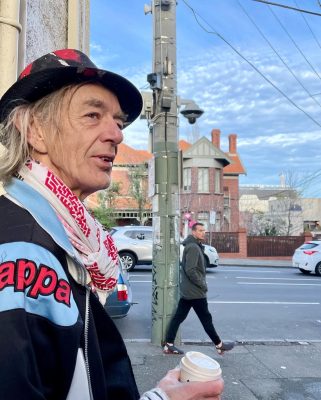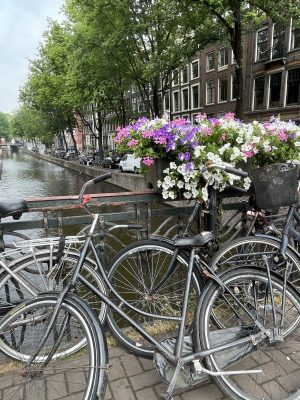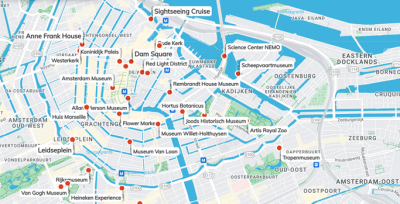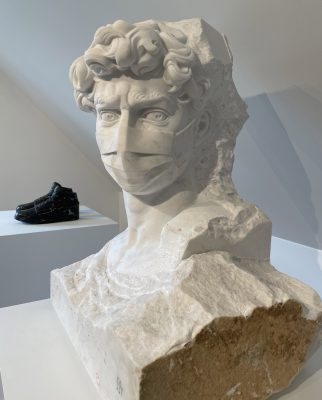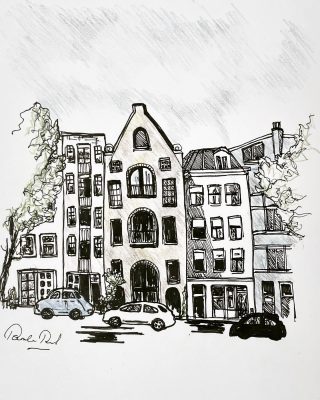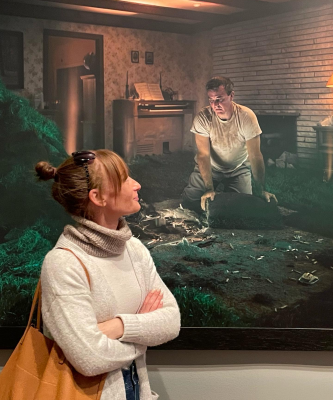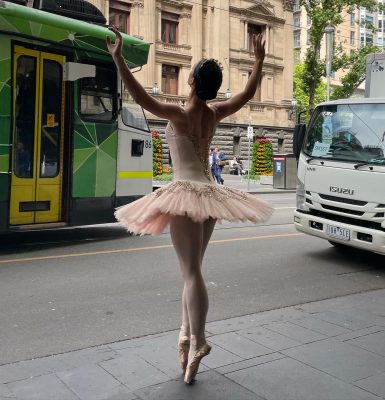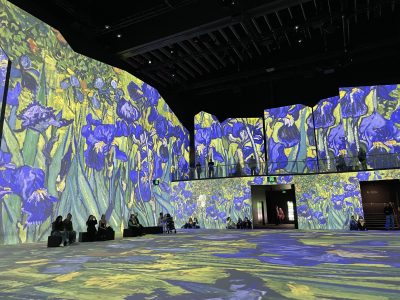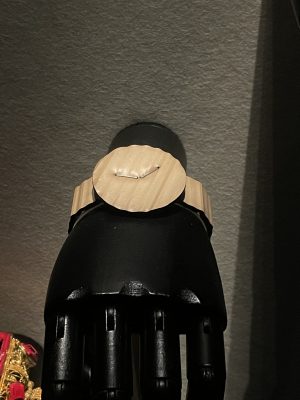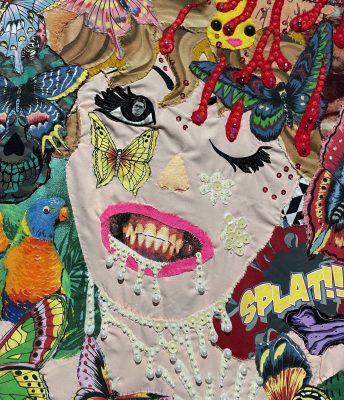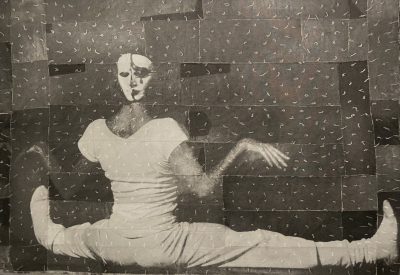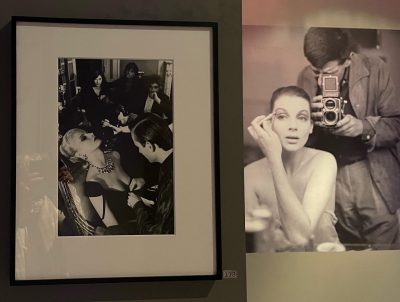Stroll Fitzroy Street any morning and you’ll greet much-loved St Kilda artist, Colin Sheppard and his dog, Disco. Even on approach, Colin’s sartorial splendour – hand-painted hat, pants, shirt, jacket – is a happy sight.
A man of many community layers, Colin’s personal history in St Kilda dates back to the 80’s. In those early days, he was window dressing for Aerial retail fashion. With eight stores across Melbourne, Colin travelled regional Victoria searching for specifically religious props. “I was looking to be provocative,” Colin tells. “The deliberately themed Bible according to Aerial windows caused a protest march down Chapel Street. ” Success!!
He also opened a second-hand clothing outlet, Swamp Thing, in a garage off Smith Street, then the Do it Baby fashion store on Barkly Street. Learning signwriting from bikies was the beginnings of what went on to be an extensive career as an artist, with cafes, shopfronts, homes, laneways and buildings being enlivened and restored by Colin’s accomplished hand-painted style.




Photos: with Simon Lamb from Black Lamb (Colin’s window signwriting); signage out front of St Kilda Sports Club, a.k.a. the Bowls Club; one of Colin’s series of local doggy portraits at the Galleon cafe.
St Kilda’s life stories are vibrant and diverse: Acland Street thronged with the temptation of bakeries and deli smells, bespoke fashion and jewellery shops for gift buying, the best in fruit’n’veg, meat and fish. I know, because I’ve lived in the area (Middle Park before moving to St Kilda) for 45 years. On weekends, I walked to meet my Dad for early morning coffee. Rotund, cigar-smoking Jewish men stood chatting outside Scheherazade, coffee aroma wafting along the strip.
Up and over the Esplanade, I went to lots of shows at The Palais. I remember Shirley McLaine, seeing ‘heartthrob’ Richard Harris as King Arthur in Camelot, with a 21 year old Marina Pryor in her first musical theatre lead role as Guinevere. Godspell too was at The Palais. Across the road at The Espy, well it rocked for as long as I can remember.
Around the corner in Fitzroy Street was another world. Italian night clubs, strip and drag at The Ritz, Pokies at the Prince, Tolarno’s Restaurant and Gallery (it’s not possible to count the fun dining we had at Mirka’s Tolarno Restaurant).
I digressed intentionally, because Colin and I share cultural, social and flamboyant memories of St Kilda. Importantly, Colin not only fondly reminisces, but he records our local history through his artistic skills.
Going back to those days in the 80’s, Colin shared an apartment with drag performer, Renee Scott. Nightly, Renee worked with Les Girls at The Ritz, and The Prince. “During the day, Renee would stroll down Fitzroy Street in high heels and a gown, walking two long-legged Afghan hounds,” says Colin. “She was a beautiful person, not shy to say what she was thinking.” There were sequinned, feather-bowered comings and goings at that apartment in Victoria Street. A couple of years ago, Colin recreated his dear friend Renee in a mural on Little Grey Street, behind Fitzroy Street and her stage home at The Ritz.
Further along Little Grey Street, Colin then completed a mural depicting Nick Cave and the Birthday Party, again appropriately situated behind The George where the band played during the Crystal Ballroom’s punk era, late 70’s-early 80s.





Photos: Little Grey Street murals. Remembering his dear friend, Renee; mid-winter, me up a ladder with Colin, Nick Cave and the Birthday Party.
Over several months last year, Colin worked meticulously at The Palais Theatre, revitalising the backstage area and staircase walls with decorative depictions of the iconic venue. Other works, beyond the street, include Luna Park, The Esplanade Hotel and his exceptional gilt gold deco painting at The Dog’s Bar which won First Prize at Melbourne Design Week (2017).
A recent challenging project, The Wall of Sound painted on weatherboard in O’Donnell Gardens, required intricate artistic skill, accuracy and continuity. It looks splendid!





Photos: Backstage at The Palais (Colin Sheppard pics); working on the Wall of Sound in O’Donnell Gardens (Deb Nightingale and Rosie Haenson pics); detail of Wall of Sound.
Colin’s diligence is such that he continues through changing weathers conditions – some chilly days – with pride and artistic integrity. The joy he brings to our community is evidenced by the friends and passers-by who stop to talk while he works, want to be photographed and share his lively art on their social media. “Street art gives everyone an opportunity to see it in exactly the same way, it separates the hierarchy in how they view, everyone’s on the same level,” Colin explains. “And, the stories I get. When I first started thinking about Renee’s mural, I didn’t think many would know her, but I was overwhelmed. There were easily 200 people who came up to me when I was working on it. Some had 30 seconds to comment, others spent 20 minutes telling their stories.”
Importantly to me – and what I believe is measurable – is that Colin’s craftsmanship records St Kilda’s luminous past to present, ensuring its longevity. As an artist, he’s an historian, an ‘on the street’ archivist. Colin paints the faces of his St Kilda community. “I’m in love with the whole place. In the past, I thought about moving, looked on the other side of the city, but always wanted to come back. St Kilda is home.”




How lucky is St Kilda to have Colin, our very own Man of Colours.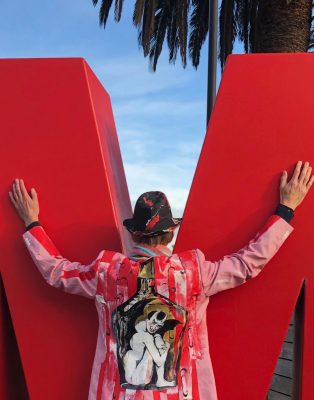
Photo: Outside Metropol, Fitzroy St., St Kilda
© 2024 Text and photos: Pamela Reid
